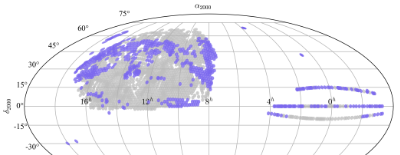MaNGA DR17 Overview
DR17 is the final MaNGA data release, containing all observations and data products for the complete sample of over 10,000 galaxies.
MaNGA is a component of the Fourth-Generation Sloan Digital Sky Survey whose goal is to map the detailed composition and kinematic structure of nearby galaxies. MaNGA uses integral field unit (IFU) spectroscopy to measure spectra for hundreds of points within each galaxy. For a general introduction to MaNGA, see the MaNGA survey page; for an overview on what has changed since DR15/DR16 see What's New in DR17.


MaNGA Data
DR17 Scope and Status
DR17 includes data for 11,273 MaNGA data cubes, 10,145 of which correspond to high-quality galaxy observations (i.e., discounting the Coma, IC342, M31, and globular cluster ancillary programs, and cubes with UNUSUAL or CRITICAL data quality flags). Of these 10,145 there are 10,010 unique galaxies (see What's New in DR17) and a small number of repeat observations.
The MaNGA data available in DR17 consist of all raw data from the survey, the intermediate/final data reduction pipeline (DRP) products, and derived data products from the data analysis pipeline (DAP). These derived data products include maps of emission line fluxes, gas and stellar kinematics, and stellar population properties. DR17 represents a major update to the MaStar stellar library consisting of reduced stellar spectra observed using the MaNGA IFU fiber bundles during the APOGEE-2 bright-time observing program. For more information on accessing MaNGA data, see the Data Access section below. DR17 also contains new MaNGA Value Added Catalogs, these can be found here.
Data Access
MaNGA data can also be accessed using several SDSS interfaces.
Marvin
Marvin is a tool for accessing, visualizing, and analyzing MaNGA data on the web and on your computer. For more information see the Marvin page.
Science Archive Server (SAS)
MaNGA data cubes, row-stacked spectra, and the drpall summary table are available as FITS files through the Science Archive Server (SAS), which can return FITS spectra either individually or in bulk. For more information on retrieving MaNGA data from the SAS, see the MaNGA Data Access page for details.
CasJobs
You can search for MaNGA data within the drpall summary table more flexibly with the CasJobs data access tool. With CasJobs, you can submit large queries that run for up to 8 hours and can return millions of objects. You can save results into a personal MyDB database for later analysis.
MaNGA data are part of the DR17 context - don't forget to change to the DR17 context when you want to find MaNGA data. MaNGA summary data are in the mangaDrpAll table, and targeting data are available in the mangatarget table.
SkyServer
Information for individual MaNGA targets are also shown in the SkyServer Explore tool, such as for this sample MaNGA target galaxy. The SkyServer site includes direct links to the MaNGA data cubes stored on the SAS.
You can search for MaNGA data using Structured Query Language (SQL) with the SkyServer SQL Search tool. MaNGA summary data are in the mangaDrpAll table, and targeting data are available in the mangatarget table.




